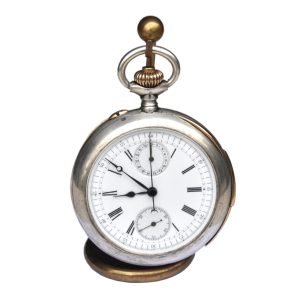Repeater (horology)
A repeater is a complication in a mechanical watch or clock that chimes the hours and often minutes at the press of a button. There are many types of repeater, from the simple repeater which merely strikes the number of hours, to the minute repeater which chimes the time down to the minute, using separate tones for hours, quarter hours, and minutes. They originated before widespread artificial illumination, to allow the time to be determined in the dark, and were also used by the visually impaired. Now they are mostly valued as expensive novelties by watch and clock enthusiasts. Repeaters should not be confused with striking clocks or watches, which do not strike on demand, but merely at regular intervals.
History
The repeating clock was invented by the English cleric and inventor, the Reverend Edward Barlow in 1676. His innovation was the rack and snail striking mechanism, which could be made to repeat easily and became the standard mechanism used in both clock and watch repeaters ever since. The best kind of repeating clocks were expensive to make; a separate train of wheels had to be added to the striking mechanism, and to activate it one pulled a cord whereupon it would strike the hours and quarters, or even the hours and five-minute divisions (five minutes repeating). During the nineteenth century such clocks gradually went out of use. Due to cheap imports from France, Germany and America English clockmaking went into decline and with the advent of gas lighting repeating clocks became an unnecessary luxury.
Both Edward Barlow and Daniel Quare claimed the invention of the repeating watch, just before 1700. Both applied for a patent on it, which was decided in favor of Quare in 1687. Repeater watches were much harder to make than repeater clocks; fitting the bells, wire gongs and complicated striking works into a pocketwatch movement was a feat of fine watchmaking. So repeating watches were expensive luxuries and status symbols; as such they survived the introduction of artificial illumination and a few are still made today.
Whereas repeating watches made in the eighteenth century struck a bell mounted in the back of the case, during the nineteenth century wire gongs were invariably employed as they took up less space. These appear to have been invented by the Swiss around 1800. Another type of repeating watch made during the period 1750–1820 was the dumb repeating watch. These had two hammers for hours and quarters, striking blocks within the case which made a dull sounding thud which could be felt in the hand.
Generally, repeating watches strike the hours and quarters, although the best London made eighteenth century repeating mechanisms (motions) were made using the Stockten system, named after the original inventor Matthew Stockten (known also as Stockton, Stockdon or Stogden) who worked for the famous makers Daniel Quare and George Graham.
These were made to strike the hours, quarters and half quarters (7 1⁄2 minutes). From around 1750 watches this system was modified to repeat the hours, quarters and minutes (the minute repeater), the famous London maker John Ellicott appears to have been the first to produce these in numbers. During the nineteenth century following the improvements made by A.L. Breguet, the minute repeating mechanism became much more common but still to be found only in the best watches as it was expensive to make.
How they work
The rack and snail striking mechanism used in repeaters is described in detail in the striking clock article. Repeater clocks often had a cord with a button on the end protruding from the side of the clock. Pulling the cord actuated the repeater mechanism. This was called a pull repeater. Repeating carriage clocks have a button on the top to activate them.
Early watch repeater mechanisms were actuated by pushing and depressing the pendant (the top) of the watch. Later ones are activated by pushing a slide along the side of the case. This winds a separate spring to power the repeater. Releasing the slide releases the spring, and its force as it unwinds moves the repeater mechanism through its chiming sequence.
A problem with very early repeaters was that the slide could be released before it was fully cocked, causing the repeater to only chime part of its sequence. Around 1820 French watchmaker Abraham Breguet invented a reliable ‘all-or-nothing’ mechanism that prevented this, making watch repeaters considerably more reliable and popular. The first repeaters had a single bell mounted in the back of the case, on which 2 hammers would strike. This bell was made of “Bell metal”, a mixture of copper and tin. Later repeating watches use gongs made of long hardened steel wires that are coiled inside the watch case. Tiny hammers actuated by the repeater mechanism strike them to make the chiming sounds. Some of the complex repeaters, such as the minute repeater, need to produce three different sounds, to distinguish hours, quarter hours, and minutes in the striking sequence. Since it is difficult to fit three bulky wire gongs into a watch movement, virtually all repeaters use two gongs, made from the two ends of a single length of wire supported in the middle, and if a third sound is needed it is made by striking the two gongs rapidly in sequence, first the high tone and then the low: “ding-dong”.
The repeaters have a mechanism that allows the pace of the repeater strikes to be changed. The owner of a repeater watch can ask a watchmaker to change the pace, making it faster or slower. According to the book “Etablissage et Repassage des Montres à Répétition” by John Huguenin (page 39 of the original edition), “a minute repeater with an average speed takes about twenty seconds to strike 12 hours, three quarters and fourteen minutes”.
Types
Quarter repeater
The quarter repeater strikes the number of hours, and then the number of quarter hours since the last hour. The mechanism uses 2 chimes of different tones. The low tone usually signals the hours, and the high tone the quarter hours. As an example, if the time is 2:45, the quarter repeater sounds 2 low tones and after a short pause 3 high ones: “dong, dong, ding, ding, ding”. Alternatively, some use a pair of tones to distinguish the quarter hours: “dong, dong, ding-dong, ding-dong, ding-dong”
Half-quarter repeater
The half-quarter repeater can sound the time to half a quarter hour, or 7 1⁄2 minutes. It strikes hours and then quarter hours, like the quarter repeater, then it uses a single tone in order to signal if more than half of the current quarter hour has passed. For example, if the time is 3:41 the mechanism will strike 3 low tones (“dong”) to represent 3 hours, then 2 sequence tones (“ding-dong”) to represent 2 quarter hours, then one high tone (“ding”) to indicate that more than half of the third quarter hour has passed.
Five-minute repeater
First made in 1710 by Samuel Watson,[4] the five-minute repeater strikes the hours and then the number of five-minute periods since the hour. The mechanism uses a low tone for the hours and a high tone for the minutes. For example, 2:25 would be struck as: “dong, dong, ding, ding, ding, ding, ding”.
Minute repeater
The minute repeater works like the quarter repeater, with the addition that, after the hours and quarter hours are sounded, the number of minutes since the last quarter hour are sounded. This requires three different sounds to distinguish hours, quarters, and minutes. Often the hours are signaled by a low tone, the quarters are signaled by a sequence of two tones (“ding-dong”), and the minutes by a high tone. For example, if the time is 2:49 then the minute repeater will sound 2 low tones representing 2 hours, 3 sequence tones representing 45 minutes, and 4 high tones representing 4 minutes: “dong, dong, ding-dong, ding-dong, ding-dong, ding, ding, ding, ding”.
Decimal repeater
The decimal repeater works like the minute repeater, but instead of chiming the quarter hours followed by minutes, it sounds the number of ten-minute intervals after the last hour and then the minutes. For example, if the time is 2:49 then the decimal repeater will sound 2 low tones representing 2 hours, 4 sequence tones representing 40 minutes, and 9 high tones representing 9 minutes: “dong, dong, ding-dong, ding-dong, ding-dong, ding-dong, ding, ding, ding, ding, ding, ding, ding, ding, ding”. These repeaters, although first made more than 250 years ago, are very rare.
Grande sonnerie
A grande sonnerie is a quarter (or minute) striking mechanism combined with a repeater. On each quarter hour, it sounds the hours and then the quarters on two gongs. In addition it can strike the hours at the push of a button.
Dumb repeater
Used by the visually impaired and to tell the time quietly in meetings and concerts, ‘dumb’ repeater watches did not chime audibly, but instead produced vibrations. Instead of a gong, the hammer struck the hours on a solid metal block attached to the case, producing a dull ‘thud’ that could be felt in the hand.
Audocron
A student of the Ecole Technique de la Vallée de Joux created a mechanical ten minute repeater in the 1930s. Conceived of as a clock for the blind—before talking clocks, and patented (3,925,777) in 1974, this electronic repeater called the Audocron was manufactured in the U.S. When touched it chimed out the hour, then in a higher tone—the tens of minutes, followed by the minutes in the original tone. There was a 1 1⁄2-second space between the groups. About 18,000 were made in the U.S. and sold worldwide.
















